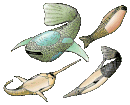Arandaspis
| Arandaspis | |
|---|---|

| |
| Fossil of Arandaspis prionotolepis from Natural History Museum in London | |
| Scientific classification | |
| Domain: | Eukaryota |
| Kingdom: | Animalia |
| Phylum: | Chordata |
| Infraphylum: | Agnatha |
| Class: | †Pteraspidomorphi |
| Order: | † Arandaspidiformes
|
| Family: | † Arandaspididae
|
| Genus: | †Arandaspis Ritchie & Gilbert-Tomlinson, 1977 |
| Type species | |
| †Arandaspis prionotolepis Ritchie & Gilbert-Tomlinson, 1977
| |
| Species[1] | |
| |
Arandaspis prionotolepis is an extinct species of jawless fish that lived in the Ordovician period, about 480 to 470 million years ago. Its remains were found in the Stairway Sandstone near Alice Springs, Australia in 1959, but it was not determined that they were the oldest known vertebrates until the late 1960s. Arandaspis is named after a local Indigenous Australian people, the Aranda (now currently called Arrernte).
Description

Arandaspis is estimated to reach around 12–14 cm (5–6 in) long, with a body covered in rows of knobbly armoured
caudal fin would be simple shape,[2] although another arandaspid Sacabambaspis had the tail that consist dorsal and ventral webs and an elongated notochordal lobe.[3]
See also
References
- ^ "Pteraspidomorphi". Retrieved 28 October 2013.
- ^ ISSN 0311-5518.
- PMC 2373808.
External links
 Media related to Arandaspis at Wikimedia Commons
Media related to Arandaspis at Wikimedia Commons






